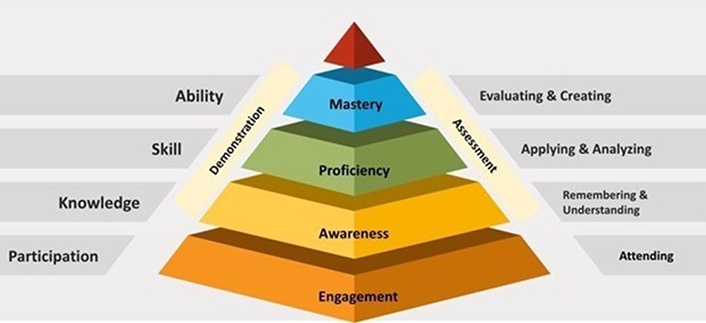Creating a taxonomy that can be embraced across the field of digital badging is critical for shared meaning, transparency, and transferability.

Digital badges are being used across government agencies, private- and public-sector employers, the K–16 education landscape, and beyond to represent the achievement and acquisition of knowledge, skills, abilities, and competencies. The concept of the "lifelong learner" who moves in and out of educational institutions, professional positions, and community organizations is a reality. Competencies and skills acquired in one domain may prepare the badge earner for future learning and performance in another domain. Creating a taxonomy that can be embraced across the field of digital badging—one that uses consistent language and strategies for categorizing these accomplishments—is critical for shared meaning, transparency, and transferability across the domains traversed by the lifelong learner.
How Was the Taxonomy Derived?
The digital badge taxonomy proposed here starts with Swapna Gottipati and Venky Shankararaman's competency cube, which maps a modified version of the Bloom taxonomy of cognitive competencies to the Dreyfus model of skill acquisition.Footnote1 Bloom's modified taxonomy expresses the six levels of cognitive learning—Evaluating, Creating, Analyzing, Applying, Understanding, and Remembering—in a way that enables the definition of learner-centered, measurable learning outcomes with increasing levels of competency. Gottipati and Shankararaman then mapped Bloom's cognitive taxonomy to three of the skill stages—Awareness, Proficiency, and Mastery—in the Dreyfus model. Their competency cube thus provided a connection between language used inside and outside of academia.
In the digital badge taxonomy pyramid (see figure 1), these skill stages are further connected to terms used by employers to describe employees' knowledge, skills, and abilities (KSAs).Footnote2 The pyramid also highlights the levels at which there is a requirement for assessment and demonstration of skills and competencies. Finally, the lower level of the digital badge taxonomy pyramid adds Engagement to the skill stages and Attending to the cognitive competencies as a way to represent badges that are issued without an assessment or demonstration.

What Are the Change Management Considerations for Existing Badging Programs?
The variety of "credentials'' being represented by badges ranges from basic participation (e.g., attendance at a conference or workshop) to conferred degrees and certifications. And in some cases, institutions and organizations have defined their own taxonomies very specific to their programming, often categorizing their badges based on level of mastery. Because the digital badge taxonomy proposed here focuses on the most basic measurement of competency—that is, a learning outcome—it can be applied to existing badging programs by evaluating the individual outcomes described within a badge to ensure the level described is consistent with the levels defined in the taxonomy.
What Are the Implications?
Whether a digital badge is used as a container to represent successful completion of a degree program or as a module in a course with a single competency, this digital badge taxonomy supports both the classification and the description of that achievement in language that has consistent meaning inside and also outside of academia—and anywhere else along the lifelong learning continuum where badges are earned and awarded.
Notes
- Swapna Gottipati and Venky Shankararaman, "Competency Analytics Tool: Analyzing Curriculum Using Course Competencies," Education and Information Technologies 23, no. 1 (2018), available at the Research Collection School of Computing and Information Systems, at Singapore Management University. Jump back to footnote 1 in the text.
- The basic concept of this taxonomy was born from a digital badging initiative at the University of Maryland, Baltimore County in collaboration with the Greater Washington Partnership. The latter is a program in which regional employers work with higher education institutions to define and describe the learning outcomes and competencies that graduates need to be successful in the regional job market. While the taxonomy was not used in any "official" form, this initiative was the first pilot of a rudimentary taxonomy. Jump back to footnote 2 in the text.
Sherri N. Braxton is Senior Director for Digital Innovation at Bowdoin College.
© 2022 Sherri N. Braxton. The text of this work is licensed under a Creative Commons BY-NC-ND 4.0 International License.
